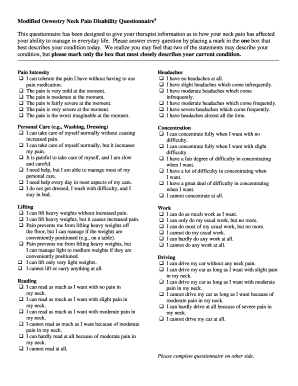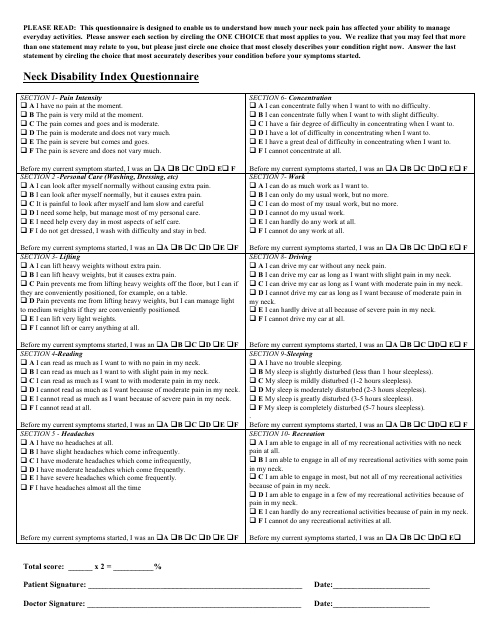Neck Disability Index Spanish Pdf
Posted By admin On 08.01.21
The Spine Tango patient self-assessment form containing the Core Outcome Measures Index (COMI), whose items were originally suggested by Deyo et al. 1998 and which was subsequently validated as an outcome instrument in itself by Mannion et al. 2005 and Ferrer et al. 2006, to then become the official outcome instrument of Spine Tango. Neck disability index this questionnaire is designed to help us better understand how your neck pain affects your ability to manage everyday -life activities.please mark in each section the one box that applies to you. Although you may consider that two of the statements in any one section relate to you, please mark the box that most closely describes your present -day situation.
Neck Disability Index Spanish Version
How does the neck disability index (NDI) calculator work?
- Grow your communities through Groups, promote and manage your events using Peatix's robust tools on the web and the app. Simple, transparent, low fees. Customer-centric support.
- The Oswestry Disability Index (also known as the Oswestry Low Back Pain Disability Questionnaire) is an extremely important tool that researchers and disability evaluators use to measure a patient's permanent functional disability. The test is considered the ‘gold standard’ of low back functional outcome tools 1. Scoring instructions.
This is a health tool that evaluates the effect cervical spine neck pain has had on the subject in terms of lifestyle day to day activities.

The NDI is based upon the Oswestry Low Back Pain Disability Index and is a self report condition specific questionnaire. The 10 items addressing functional status are listed below.
■ Pain Intensity - pain occurrence and perceived severity;
■ Personal Care (Washing, Dressing etc.) – ability to care for oneself and degree of perceived accuracy in doing so;
■ Lifting – capacity to lift different weights and pain occurrence while doing so;
■ Reading – degree of experienced pain in the neck during and in different reading positions;
■ Headache – frequency and perceived severity of recurrent headaches;

■ Concentration – degree of difficulty in concentration;
■ Work – comparison between past and actual work capacity;
■ Driving – ability to drive and length of time to drive before pain starts;
■ Sleeping – quantifies sleep disturbance in terms of time;
■ Recreation – perceived impairment to partaking in leisure activities.
Each of them comprises of 5 answer choices, varying in severity of pain or degree of movement, activity impairment from A to F. Therefore choice A carries 0 points while question F weighs 5 points.
Nowadays the neck disability index is one of the most used measures for neck pain and has been translated in several languages. Going through the questionnaire should take between 2 to 9 minutes with mean duration values in the studies placed between 3 and 7.8 minutes.
After the original study in 1991, several validation studies have ensued with different reliability outcomes.
The neck disability index (NDI) calculator can be used to evaluate current status but also to monitor disability evolution or response to treatment. Current recommendation suggest the tool to be used at baseline and then fortnightly for monitoring purposes.
However, it appears that a change of at least 5 points in most conditions or 10 in mechanical neck pain and 13 in cervical radiculopathy, can be recognized as clinically meaningful. During recovery patients usually score between 5 to 20 overall in the disability status.
The NDI testing resulted in a fair to moderate test-retest reliability in patients with mechanical neck pain but also for patients with cervical radiculopathy .
Also the following populations have been tested:

■ Cervical radiculopathy;
■ Neck pain: Chronic, non-specific;
■ Neck pain: Chronic, non-traumatic;
Shoulder Disability Index
■ Neck pain: Chronic, uncomplicated;
■ Neck pain: Degenerative, post-traumatic and other;
■ Neck pain: Mechanical;

Neck Disability Index Questionnaire
■ Neck pain: With or without arm pain.
Therefore the tool is seen as valid in evaluating neck pain and outcomes in patients with either acute or chronic conditions, whiplash associated conditions as well as musculoskeletal dysfunctions.
NDI score interpretation
As explained above, each of the 10 items consists of 5 answer choices with points from 0 to 5. This means that the overall score range is between 0 and 50, 0 being no to little pain and discomfort while 50 being the severest degree of pain and disability with complete activity limitation.
The score is sometimes expressed in percentage as well. The higher the score, the higher the perceived impairment in this disability rating scale for neck injuries.
Although the original study does not provide specific benchmarks or cut off points, there are several interpretations available, although not completely validated, such as that of Vernon and Moir, described below:
■ 0-4 points (0-8%) no disability;
■ 5-14 points ( 10 – 28%) mild disability;
■15-24 points (30-48% ) moderate disability;
■ 25-34 points (50- 64%) severe disability;
■ 35-50 points (70-100%) complete disability.
References
1) Vernon H, Mior S. (1991) The Neck Disability Index: a study of reliability and validity. J Manipulative Physiol Ther; 14(7):409-15.
2) Cleland JA, Childs JD, Whitman JM. (2008) Psychometric properties of the Neck Disability Index and Numeric Pain Rating Scale in patients with mechanical neck pain. Arch Phys Med Rehabil; 89(1):69-74.
3) Cleland JA, Fritz JM, Whitman JM, Palmer JA. (2006) The reliability and construct validity of the Neck Disability Index and patient specific functional scale in patients with cervical radiculopathy. Elvui 4.3.4. Spine (Phila Pa 1976); 31(5):598-602.
4) Hogg-Johnson S. (2009) Differences in reported psychometric properties of the Neck Disability Index: patient population or choice of methods? Spine J; 9(10):854-6.
18 Jan, 2016